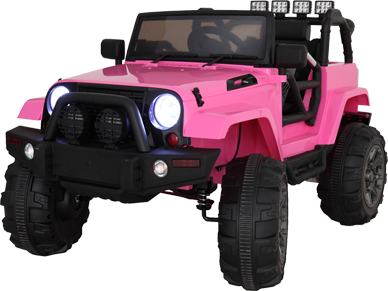- Home
- Shop
- Forest Series
- Grassland Series
- Desert Series
- Contact
- Home
- Shop
- Forest Series
- Grassland Series
- Desert Series
- Contact

Bear Series





2 DRIVING MODES
Kids manual operation and parent remote control. The off-road SUV for one kid only can be moved forward and backward with the in-car control by the pedal and steering wheel, or be overridden by parents via the 2.4GHz RC with 3 speeds.
SAFETY GUARANTEE
Structured by toughened kid-friendly plastic, the twin-motor kids vehicle built with 4 spring-suspension knobby wheels allows the little driver fastened by the safety harness to conquer different terrains with ease.
BEST GIFT FOR KIDS
This fully operational 12V ride on electric truck designed with appealing LED lights, accessible magnet doors, and a realistic Wrangler style is a perfect gift for your toddlers (3-6 years old) to begin an outdoor adventure.


CHARACTERISTICS
The Chipmunk is a member of the family Mammalia, Rodentia and Sciuridae. It is also known as the Striped Squirrel, the Timber Tiger and the Mini-bear. The body length among most Chipmunks ranges from 5.5 to 6.3 inches and the tail length is 5 Inches. Chipmunks typically weigh about 0.02 pounds and live about 5 to 10 years. They have small but prominent ears which face forwards, and small eyes on the sides of their heads. Most wild Chipmunks are lively.


Lorem ipsum dolor sit amet, consectetur adipiscing elit. Ut elit tellus, luctus nec ullamcorper mattis, pulvinar dapibus leo.


CHARACTERISTICS
The Grizzly Bear is a member of Mammalia, Carnivora, Ursidae and it is a North American subspecies of the brown bear. The term “Grizzly Bear”, however, is often applied informally to Brown Bears of North America regardless of subspecies. Grizzlies are typically brown, though their fur can appear to be white-tipped, or grizzled. The Grizzly Bear is a massive animal with humped shoulders and an elevated forehead that contributes to a somewhat concave profile. The fur is brownish to buff, and the hairs are usually silver-or pale-tipped, giving the grizzled effect for which the bear is named. The large adult Grizzly Bear may be about 8 feet long and weigh about 900 pounds. Because of the bulk and long straight claws, the Grizzly Bear rarely climbs trees.

RANGE AND HABITAT
The Grizzly once lived in much of western North America and even roamed the Great Plains. This animal needs a lot of space—its home range can encompass up to 600 square miles—so its ideal habitat is one that is isolated from development and has plenty of food and places to dig their dens. Though European settlement gradually eliminated the bear from much of its original habitat, the Grizzly can still be found in parts of Wyoming, Montana, Idaho, and Washington State. It’s one of the most iconic residents of Yellowstone National Park. Many Grizzlies also still roam the wilds of Canada and Alaska, where hunters pursue them as big game trophies.

DIET
The Grizzly is normally an omnivore and its diet consists of both plants and animals. It has been known to prey on large mammals, when available, such as moose, elk, caribou, white-tailed deer, mule deer, bighorn sheep, bison, and even black bears, though it is more likely to take calves and injured individuals rather than healthy adults. The Grizzly Bear feeds on fish such as salmon, trout, and bass, and those with access to a more protein-enriched diet in coastal areas potentially grow larger than inland individuals. The Grizzly Bear also readily scavenges food or carrion left behind by other animals. It will also eat birds and their eggs, and gather in large numbers at fishing sites to feed on spawning salmon. It frequently preys on baby deer left in the grass, and occasionally it raids the nests of raptors such as bald eagles.

BEHAVIOR
The Grizzly Bear has one of the lowest reproductive rates of all terrestrial mammals in North America. This is due to numerous ecological factors. The Grizzly Bear doesn’t reach sexual maturity until they are at least five years old. On average, females produce two cubs in a litter and the mother cares for the cubs for up to two years, during which the mother will not mate.
The gestation period for Grizzly Bears is approximately 180–250 days. Litter size varies between one and four cubs, typically comprising twins or triplets. Cubs are always born in the mother’s winter den while she is in hibernation. Female Grizzlies are fiercely protective of their cubs, being able to fend off predators, including larger male bears. Cubs feed entirely on their mother’s milk until summer comes, after which they still drink milk but begin to eat solid foods. Cubs gain weight rapidly during their time with the mother—their weight will have increased from 4.5 to 45 kg (10 to 99 lb) in the two years spent with the mother.
Grizzly Bears hibernate for 5 to 7 months each year(except where the climate is warm, as the California grizzly did not hibernate). During this time, female Grizzly Bears give birth to their offspring, who then consume milk from their mother and gain strength for the remainder of the hibernation period. To prepare for hibernation, grizzlies must prepare a den, and consume an immense amount of food as they do not eat during hibernation. Grizzly Bears do not defecate or urinate throughout the entire hibernation period. The male Grizzly Bear’s hibernation ends in early to mid-March, while females emerge in April or early May.

The Chipmunk is a member of the family Mammalia, Rodentia and Sciuridae. It is also known as the Striped Squirrel, the Timber Tiger and the Mini-bear. The body length among most Chipmunks ranges from 5.5 to 6.3 inches and the tail length is 5 inches. Chipmunks typically weigh about 0.02 pounds and live about 5 to 10 years. They have small but prominent ears which face forwards, small eyes on the sides of their heads. Most wild Chipmunks are lively.
The Red Squirrel, a member of the Sciuridae, is an arboreal, omnivorous rodent often referred to as a Forest Seeder and folklore as the Devil King Squirrel.
The Arizona Gray Squirrel, also known as the American Gray Squirrel, is a member of the family Rodentia and Sciuridae. It is small in size, with gray fur and a belly between white and cream. It has long ears, no tufts of fur and a fluffy tail edged in white. The body is about 16-20 inches long and weighs up to 1.4 pounds.
The Rock Squirrel, also known as Sao Maozi or Stone Mouse, belongs to the rodent and is a species in the family Sciuridae. The most common natural predators of the Rock Squirrel include bobcats, owls, eagles and snakes. Though the Rock Squirrel is cute, alert, and courageous, it is still considered a pest due to its habit of destroying crops.
The Abert’s Squirrel is a member of the genus Sciurus with a body length of 18-22.8 inches, a tail length of 7.5-9.8 inches and a weight of 2.2 pounds, and can live up to 10 years in the wild. Its most distinctive feature is tassels of fur about 0.8-1.2 inches long at the tip of its ears, which looks very interesting. In addition, it is alert and agile.

Watch a Big Grizzly Bear Chase an Oil Field Worker Onto the Roof of a Semi-Truck
A worker at a remote oil field in Alaska recently had a close call with a charging grizzly bear—and his colleague caught the whole ordeal on camera. In the startling video, an employee at an Arctic pipe inspection yard at Prudhoe Bay can be seen lunging for the safety of a semi-truck roof as a grizzly sow bum-rushes the vehicle from below.
The immensity of the big grizzly is immediately apparent when she puts her front paws up against the truck’s cab, just above the gas tank, and stands upright. The cornered oil worker looks down from the relative safety of his perch. In an interview with USA Today, another employee who saw the encounter said that the sow became agitated when she lost sight of one of her two cubs. The sow and her cubs have been spotted in the yard before, and according to the Alaska Department of Fish and Game (ADFG), the bears habitually feed from dumpsters in the area.



Follow Us: